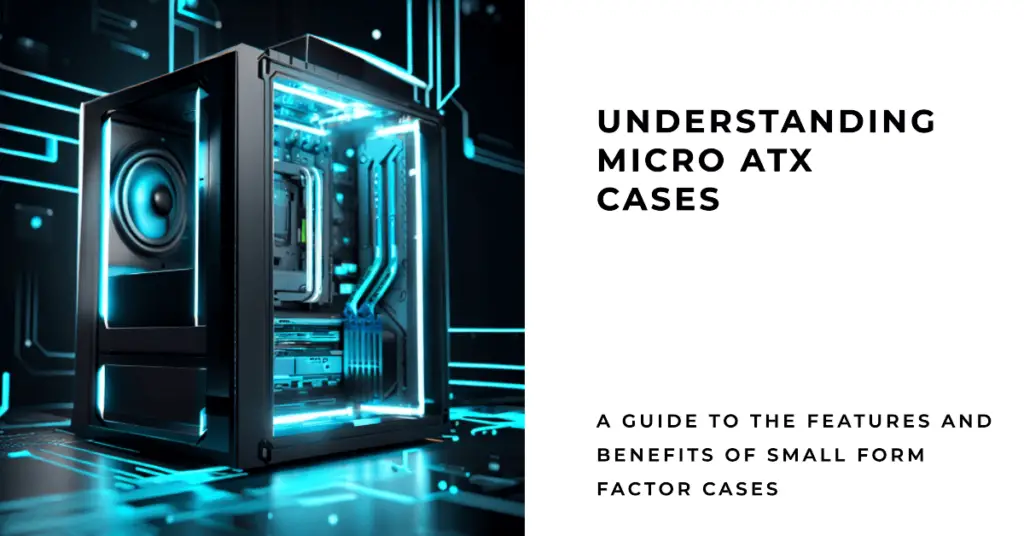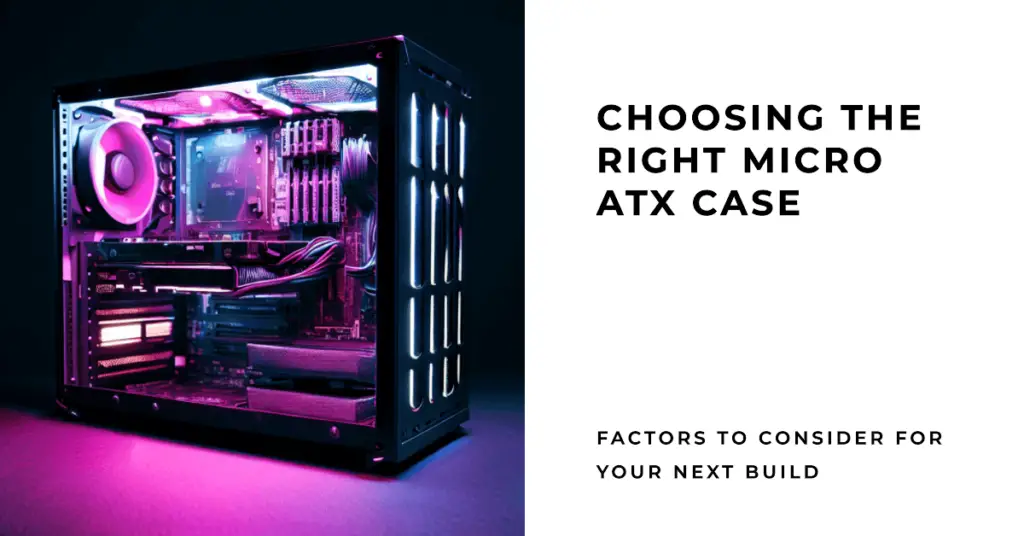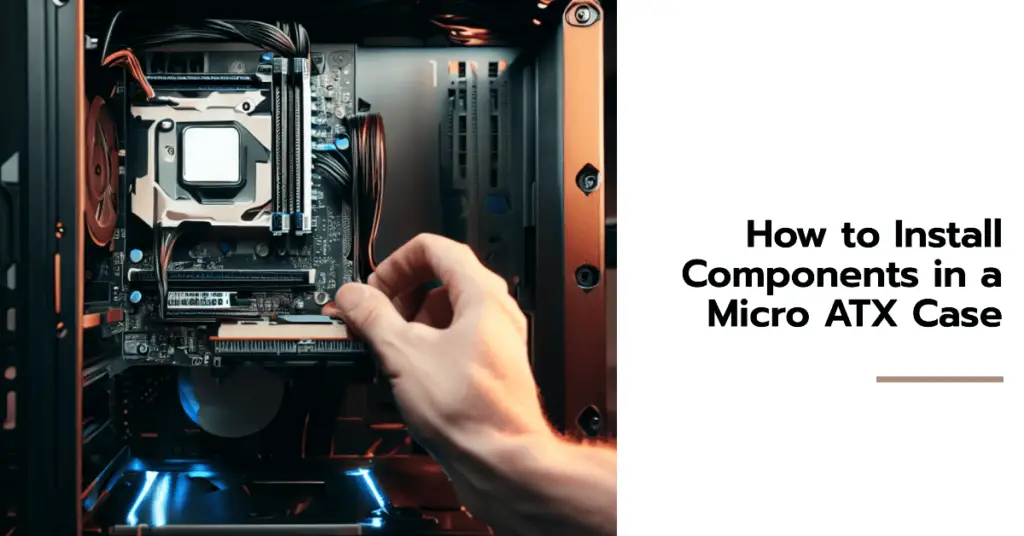Assembling the perfect compact PC setup is no easy task. It’s an intricate puzzle with countless pieces that must fit together seamlessly. The heart of this puzzle?
The case. Finding the right one can often be daunting, especially when balancing size, compatibility, cooling, and aesthetics.
Yet, it is integral to house your components and ensure optimal performance. Among the various sizes available, the Micro ATX case poses unique challenges.
You’re not alone if you’ve spent countless hours scouring the internet, sifting through reviews, product descriptions, and forums, only to be left with a dizzying array of options and more questions than answers.
You may have found a visually appealing case that doesn’t provide adequate airflow. Or perhaps one that’s the perfect size but lacks the expansion slots you need. This process can be frustrating and time-consuming, often leaving you unsure of the best choice.
But worry no more! This comprehensive guide is here to solve your Micro ATX case dilemma. We evaluated and compared the top Micro ATX cases using our expert knowledge and extensive research.
We will guide you through understanding a Micro ATX case, the factors to consider when choosing one, and the top picks in different price segments. We will ensure you can confidently select the best Micro ATX case that fits your needs, budget, and style.
Let’s dive in to make your PC building experience smoother and more rewarding!
Understanding Micro ATX Cases
Micro ATX cases hold a significant position in computer hardware due to their compact yet versatile nature. These cases, also known as uATX cases, are designed to house Micro ATX motherboards, which offer a balance between functionality and space-saving dimensions.
Micro ATX cases exhibit a unique form factor that differentiates them from their larger counterparts. With dimensions typically around 9.6 x 9.6 inches, they are notably smaller than ATX and Extended ATX cases, making them an ideal choice for those seeking a more compact desktop setup.
Despite their reduced size, Micro ATX cases often feature impressive capabilities. They typically offer multiple expansion slots, allowing users to integrate components like graphics cards, storage drives, and memory modules. Moreover, these cases are compatible with standard ATX power supplies, providing ample energy for demanding systems.
One advantage of Micro ATX cases is their affordability, as they are generally priced more competitively than larger form factors. Additionally, their compact design allows users to build a powerful system within a smaller footprint, making them a popular choice for gaming enthusiasts and media professionals.
Micro ATX cases often incorporate clever interior layouts, cable management systems, and efficient cooling mechanisms to optimize space utilization. These features help maintain adequate airflow and prevent heat buildup, ensuring optimal performance and longevity for the components housed within.
In conclusion, Understanding Micro ATX Cases entails recognizing their compact size, compatibility with Micro ATX motherboards, and cost-effectiveness and space optimization advantages. Embracing these diminutive powerhouses opens possibilities for creating high-performance systems in limited spaces.
Factors to Consider when Choosing a Micro ATX Case
When venturing into Micro ATX cases, several factors merit careful consideration to ensure an optimal choice for your needs. These compact powerhouses come in various shapes and sizes, catering to various requirements and preferences.
1. Size and Form Factor: Begin by assessing the dimensions of the Micro ATX case. Ensuring it can accommodate your desired components while fitting within your available space is crucial. Consider the form factor’s aesthetics and how it aligns with your design vision.
2. Expansion Slots and Compatibility: Evaluate the number of expansion slots the case offers. This determines the potential for future upgrades and component additions, such as graphics cards and storage drives. Verify the case’s compatibility with your chosen Micro ATX motherboard to avoid compatibility issues.
3. Cooling Capabilities: Efficient cooling is vital to maintain optimal performance and prevent overheating. Look for features like fan mounts, ventilation grilles, and support for liquid cooling solutions. A well-ventilated case with adequate airflow can help prolong the lifespan of your components.
4. Cable Management and Internal Layout: An organized and clutter-free interior aids in airflow optimization and ease of component installation. Seek cases with cable management solutions like routing channels and tie-down points to keep cables neatly arranged.
5. Build Quality and Aesthetics: Consider the case’s materials, build quality, and overall aesthetics. High-quality construction ensures durability and longevity. Choose a design that complements your style and blends harmoniously with your setup.
6. Connectivity and Front Panel: Evaluate the case’s front panel connectivity options, including USB ports, audio jacks, and additional features such as built-in fan controllers or LED lighting controls. Ensure they align with your connectivity requirements.
By carefully weighing these factors to consider when choosing a Micro ATX case, you can make an informed decision that aligns with your needs and preferences. Selecting the right case sets the foundation for a reliable and visually appealing computer system.
Best Micro ATX Cases For Aesthetics and Functionality
1. Corsair 4000D – Editors Choice
When selecting the best micro ATX case, the Corsair 4000D Airflow Tempered Glass Mid-Tower ATX PC Case in Black stands out as a top contender. With its exceptional design and features, it caters to the needs of both gamers and enthusiasts seeking a compact yet powerful build.
The Corsair 4000D showcases a stunning blend of form and function. Its sleek black exterior, accentuated by tempered glass side panels, exudes elegance while providing a clear view of the meticulously crafted internals. This case strikes the perfect balance between aesthetics and practicality.
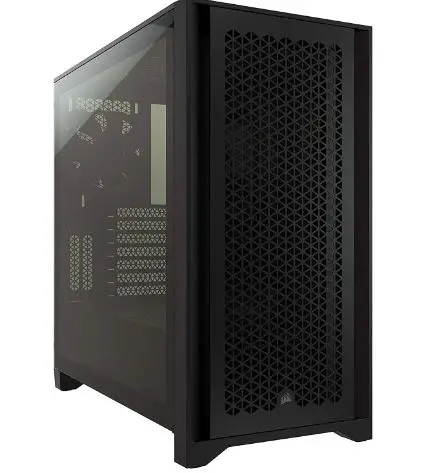
In terms of build quality, the Corsair 4000D is constructed with precision and durability in mind. Its solid steel frame ensures structural integrity, while the ample ventilation and airflow design promote efficient cooling, preventing thermal issues even during intense gaming sessions.
One of the standout features of the Corsair 4000D is its flexibility when it comes to component compatibility. It accommodates Micro ATX motherboards and supports a wide range of high-performance hardware, including large graphics cards and multiple storage drives. This versatility makes it an excellent choice for users looking to build a compact yet capable system.
The case also excels in cable management. With its convenient routing channels and tie-down points, you can achieve a clean and organized interior, ensuring unimpeded airflow and a visually pleasing build.
Furthermore, the Corsair 4000D offers ample room for expansion, featuring multiple fan mounts and radiator support for liquid cooling solutions. This allows users to customize their cooling setup according to their specific requirements.
In conclusion, the Corsair 4000D Airflow Tempered Glass Mid-Tower ATX PC Case in Black embodies the essence of the best micro ATX case. Its sleek design, robust construction, component compatibility, efficient cooling, and thoughtful cable management options make it an exceptional choice for building a compact, yet powerful, system.
Pros:-
Impressive Design: The Corsair 4000D features a sleek black exterior and tempered glass side panels, providing an elegant, modern aesthetic that enhances any build.
Build Quality: Constructed with a solid steel frame, the case ensures durability and structural integrity, offering long-term reliability.
Component Compatibility: The Corsair 4000D supports Micro ATX motherboards and accommodates high-performance hardware, including large graphics cards and multiple storage drives, making it versatile for various builds.
Efficient Cooling: The case’s airflow-focused design and ample ventilation allow for excellent cooling performance, preventing thermal issues even during demanding tasks.
Cable Management: With convenient routing channels and tie-down points, the Corsair 4000D facilitates clean cable management, improving airflow and creating a tidy interior.
Expansion Options: The case provides multiple fan mounts and radiator support, allowing users to customize their cooling setup according to their preferences.
Cons:-
Limited Space: Being a Micro ATX case, the Corsair 4000D has a smaller form factor, which may restrict the number of expansion slots and potential for future upgrades compared to larger cases.
Price: As a premium case with exceptional features, the Corsair 4000D may have a higher price point than other Micro ATX cases.
Potential Size Constraints: While the case is designed to accommodate most components, larger or oversized components may not fit comfortably within the limited interior space.
Tempered Glass Fragility: Although the tempered glass side panels add visual appeal, they are more prone to breakage than acrylic panels, requiring careful handling.
It’s important to weigh these pros and cons based on individual needs and priorities when considering the Corsair 4000D as the best Micro ATX case for your specific build.
Ideal User and Use Cases:-
The Corsair 4000D is an excellent choice for users seeking a high-quality Micro ATX case that balances aesthetics, functionality, and performance.
Here are some ideal user profiles and use cases for this case:
Gamers and Enthusiasts: Gaming enthusiasts who desire a compact, powerful gaming rig will appreciate the Corsair 4000D. Its ability to accommodate large graphics cards and multiple storage drives allows for an immersive gaming experience without compromising performance.
Content Creators: Video editors, graphic designers, and content creators often require a reliable and efficient system. The Corsair 4000D’s excellent cooling capabilities and spacious interior for accommodating high-performance components make it an ideal choice for professionals working on demanding tasks.
Compact Workstations: Professionals or students needing a compact yet capable workstation can benefit from the Corsair 4000D. Its Micro ATX form factor allows for a space-saving setup without sacrificing functionality, making it suitable for office environments or small workspaces.
System Builders: PC enthusiasts who enjoy customizing and building their systems will appreciate the Corsair 4000D. Its compatibility with Micro ATX motherboards and wide range of component support provides flexibility and room for expansion, allowing users to create powerful, personalized systems.
Showcase Builds: The sleek design and tempered glass side panels of the Corsair 4000D make it an ideal choice for those who want to showcase their builds. The visually appealing aesthetics allow users to display their carefully chosen components and lighting effects, creating a striking centerpiece for any setup.
Overall, the Corsair 4000D suits diverse users, including gamers, content creators, professionals, system builders, and those looking to showcase their builds. Its design, functionality, and compatibility combination make it an excellent choice for various use cases.
Check Price on Amazon2. Cooler Master MasterBox Q300L
When selecting the best micro ATX case, the Cooler Master MasterBox Q300L Micro-ATX Tower in Black (MCB-Q300L-KANN-S00) stands out as a top contender. This case combines a sleek design with thoughtful features that cater to the needs of both gamers and PC enthusiasts.
The Cooler Master MasterBox Q300L showcases a compact yet stylish design that fits seamlessly into any setup. Its black exterior exudes a sleek and professional look, while the transparent acrylic side panel allows a captivating view of the internal components.
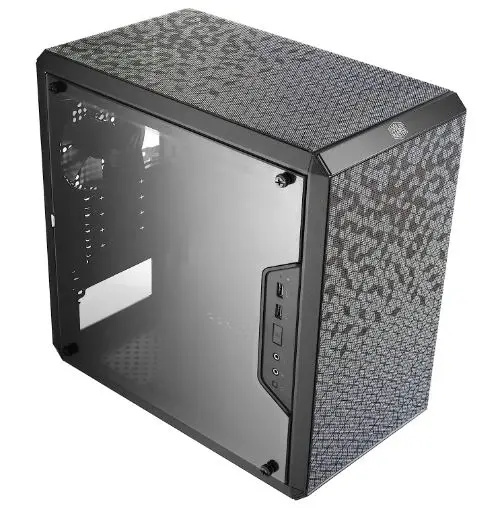
One of the standout features of the Cooler Master MasterBox Q300L is its ventilation and airflow design. The fully ventilated airflow ensures efficient cooling, keeping your components running optimally even during intense gaming sessions or resource-intensive tasks.
The case also boasts a magnetic dust filter that helps keep the internals clean and dust-free, minimizing maintenance efforts and promoting longevity for your hardware.
In terms of versatility, the Cooler Master MasterBox Q300L excels. It features an adjustable I/O panel that can be repositioned to suit your preferred orientation, providing convenient access to ports and buttons. This flexibility allows for a customized setup that caters to your specific needs.
Despite its compact size, the Cooler Master MasterBox Q300L offers ample storage and expansion options. You can build a high-performance system without compromising storage capacity or potential upgrades with support for multiple storage drives and expansion slots.
In conclusion, the Cooler Master MasterBox Q300L Micro-ATX Tower in Black (MCB-Q300L-KANN-S00) deserves recognition as the best micro ATX case.
Its sleek design, efficient ventilation, magnetic dust filter, adjustable I/O panel, and versatile storage options make it an outstanding choice for gamers and PC enthusiasts seeking a compact yet powerful build.
Pros:-
Compact and Sleek Design: The Cooler Master MasterBox Q300L features a compact form factor and a sleek design, making it an excellent choice for users looking to build a compact and stylish system.
Efficient Ventilation and Airflow: The case’s fully ventilated airflow design ensures optimal cooling for components, preventing overheating and maintaining system performance.
Magnetic Dust Filter: The included magnetic dust filter helps keep the internals clean and free from dust particles, reducing maintenance efforts and enhancing the longevity of the hardware.
Adjustable I/O Panel: The adjustable I/O panel allows users to reposition the ports and buttons to match their preferred orientation, providing convenience and customization options.
Versatile Storage and Expansion Options: Despite its compact size, the Cooler Master MasterBox Q300L offers ample storage and expansion capabilities, supporting multiple storage drives and expansion slots for potential upgrades.
Cons:-
Limited Space for Larger Components: Due to its compact size, the Cooler Master MasterBox Q300L may have limited space for larger components, such as oversized graphics cards or larger CPU coolers. Users should ensure compatibility before purchasing.
Acrylic Side Panel: While the transparent acrylic side panel provides a view of the internals, it may be more prone to scratches and may not offer the same level of durability as tempered glass panels.
Limited Cable Management Space: The compact design of the case may result in limited space for cable management, requiring extra effort to achieve a clean and tidy interior.
Potential for Noise: Although the case offers efficient ventilation, the compact design and smaller fans may result in slightly higher noise levels than larger cases with more substantial cooling solutions.
Considering these pros and cons allows users to decide whether the Cooler Master MasterBox Q300L Micro-ATX Tower is the right choice for their needs and requirements.
Ideal User and Use Cases:-
The Cooler Master MasterBox Q300L is ideal for users seeking a compact and versatile Micro ATX case.
Here are some ideal user profiles and use cases for this case:
Space-Conscious Gamers: Gamers with limited desk or room space but still want a powerful gaming rig will appreciate the Cooler Master MasterBox Q300L. Its compact size allows for a space-saving setup without compromising performance.
LAN Party Enthusiasts: The portable nature of the Cooler Master MasterBox Q300L makes it an excellent choice for LAN party enthusiasts. Its compact form factor and sturdy design make it easy to transport and set up at gaming events.
Home Office and Workstations: Professionals and individuals requiring a compact yet capable workstation will find the Cooler Master MasterBox Q300L suitable. Its compact size allows for an unobtrusive presence in a home office or small workspace, while its efficient cooling capabilities ensure optimal performance during demanding work tasks.
Media Center Builds: Users looking to build a compact media center or home theater PC can benefit from the Cooler Master MasterBox Q300L. Its sleek design and compact footprint make it an ideal choice for integrating into entertainment setups, while its ventilation ensures proper cooling for media-centric hardware.
Budget System Builders: Those on a budget who still want a reliable and functional Micro ATX case will find value in the Cooler Master MasterBox Q300L. Its affordability, with its versatile storage and expansion options, allows for creating a cost-effective system without sacrificing performance.
Overall, the Cooler Master MasterBox Q300L caters to diverse users, including space-conscious gamers, LAN party enthusiasts, professionals needing a compact workstation, media center builders, and budget system builders. Its compact design, versatility, and performance make it an ideal choice for various use cases.
Check Price on Amazon3. Thermaltake Versa H18
When selecting the best micro ATX case for airflow, the Thermaltake Versa H18 Tempered Glass Black Spcc Micro ATX Gaming Computer Case (CA-1J4-00S1WN-01) is an exceptional choice. This case combines a compact form factor with thoughtful airflow design, ensuring optimal cooling for high-performance systems.
The Thermaltake Versa H18 features a unique airflow-oriented design that prioritizes efficient cooling. Its front panel has a mesh ventilation grille, allowing for excellent air intake.
This design promotes unrestricted airflow, ensuring that components receive an adequate supply of cool air, even during intense gaming or resource-intensive tasks.
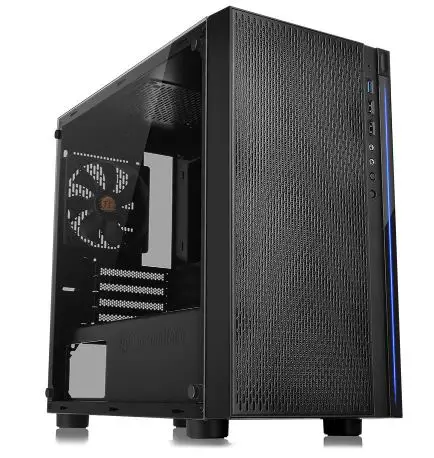
To further enhance airflow, the case supports multiple fan mounting options. Users can install additional fans on the case’s front, top, and rear to create a well-ventilated system. This flexibility allows for customized cooling setups based on individual preferences and requirements.
The Thermaltake Versa H18 also features a compact, space-saving design without compromising component compatibility. It can accommodate high-performance hardware, including Micro ATX motherboards, large graphics cards, and multiple storage drives. This versatility ensures that users can build powerful systems without sacrificing airflow optimization.
The tempered glass side panel adds a touch of elegance to the case, allowing users to showcase their carefully chosen components while maintaining good airflow. The tempered glass provides a clear view of the internals and creates a visually appealing centerpiece for any setup.
In conclusion, the Thermaltake Versa H18 Tempered Glass Black Spcc Micro ATX Gaming Computer Case (CA-1J4-00S1WN-01) is an excellent choice for those seeking the best micro ATX case for airflow.
Its airflow-oriented design, multiple fan mounting options, compact form factor, and tempered glass side panel make it an outstanding option for users looking to build a high-performance system with efficient cooling capabilities.
Pros:-
Optimized Airflow Design: The Thermaltake Versa H18 features a mesh front panel and thoughtful ventilation, ensuring efficient airflow and excellent cooling performance for high-performance systems.
Multiple Fan Mounting Options: The case supports additional fan installations on the front, top, and rear, allowing users to customize their cooling setup according to their specific requirements and preferences.
Compact and Space-Saving: The compact form factor of the Thermaltake Versa H18 makes it an ideal choice for users with limited space. It balances a compact footprint and ample room for high-performance components.
Component Compatibility: Despite its compact size, the Thermaltake Versa H18 can accommodate Micro ATX motherboards, large graphics cards, and multiple storage drives, ensuring compatibility with a wide range of high-performance hardware.
Tempered Glass Side Panel: Including a tempered glass side panel adds a touch of elegance and allows users to showcase their components while maintaining good airflow and cooling performance.
Cons:-
Limited Radiator Support: The Thermaltake Versa H18 has limited space for radiator installation, which may limit liquid cooling options for users who prefer advanced cooling solutions.
Limited Cable Management Space: Due to its compact design, cable management space may be limited in the Thermaltake Versa H18. Extra effort may be required to achieve a clean and organized interior.
Potential for Noise: While the case offers efficient airflow, the compact size and smaller fans may result in slightly higher noise levels than larger cases with more substantial cooling solutions.
Limited Expansion Slots: The compact form factor of the Thermaltake Versa H18 means that it has a limited number of expansion slots, potentially limiting future upgrades or adding extra components.
Considering these pros and cons allows users to decide whether the Thermaltake Versa H18 Micro ATX Case is the right choice for their needs.
Ideal User and Use Cases:-
The Thermaltake Versa H18 Micro ATX Case is ideal for users seeking efficient airflow and a compact form factor. Here are some ideal user profiles and use cases for this case:
Gamers and Enthusiasts: Gaming enthusiasts prioritizing airflow and cooling for their high-performance systems will find the Thermaltake Versa H18 ideal. Its optimized airflow design and multiple fan mounting options ensure proper cooling during intense gaming sessions.
Space-Conscious Users: Users with limited desk or room space will appreciate the compact form factor of the Thermaltake Versa H18. Its space-saving design allows for a smaller footprint while still accommodating powerful components.
Content Creators and Professionals: Content creators and professionals who require a compact yet capable system will benefit from the Thermaltake Versa H18. Its efficient airflow design ensures optimal cooling during resource-intensive tasks like video editing or 3D rendering.
LAN Party Enthusiasts: The portable nature of the Thermaltake Versa H18 makes it a great choice for LAN party enthusiasts. Its compact form factor and efficient airflow allow for easy transportation and setup at gaming events.
Budget System Builders: Users on a budget who still want reliable cooling performance will find value in the Thermaltake Versa H18. Its affordable price point and efficient airflow design make it suitable for building cost-effective systems.
Overall, the Thermaltake Versa H18 Micro ATX Case caters to various users, including gamers, space-conscious individuals, content creators, LAN party enthusiasts, and budget system builders.
Its efficient airflow, compact form factor and versatility make it an excellent choice for various use cases that prioritize cooling performance and space optimization.
Check Price on Amazon4. GIM Micro ATX PC Case
Regarding the Best high-end Micro ATX case, the GIM Micro ATX PC Case with 2 Tempered Glass Panels emerges as a top contender. This compact gaming PC case offers a winning combination of aesthetics, functionality, and convenience.
The GIM Micro ATX PC Case boasts two tempered glass panels that provide a stunning view of the internal components. The sleek black design and tempered glass panels create a visually appealing centerpiece for any gaming setup.
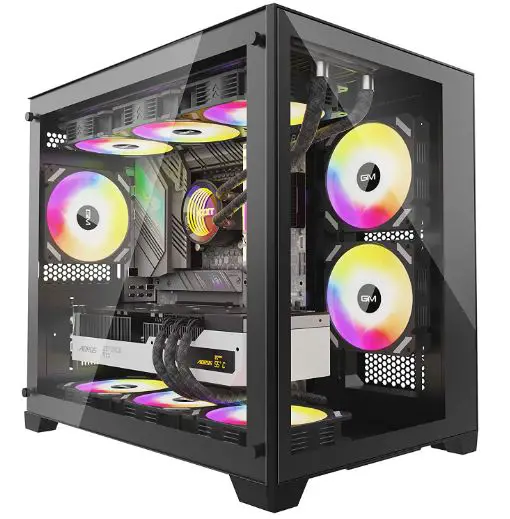
With its compact form factor, the GIM Micro ATX PC Case is designed to accommodate Micro ATX motherboards, making it an ideal choice for gamers and PC enthusiasts looking to build a powerful system in a limited space.
This case emphasizes practicality by including two magnetic dust filters that help keep the internals clean and free from dust particles. This feature reduces maintenance efforts and promotes the longevity of the hardware.
Regarding connectivity, the GIM Micro ATX PC Case offers a USB 3.0 I/O port for fast and convenient data transfers. This feature enhances usability and ensures seamless connectivity with external devices.
While the case does not have included fans, it provides ample room for customizing the cooling setup according to individual preferences. Users can select and install fans that suit their specific cooling requirements, resulting in optimal airflow and temperature management.
Overall, the GIM Micro ATX PC Case with 2 Tempered Glass Panels is the Best high-end Micro ATX case. Its striking design, compatibility with Micro ATX motherboards, magnetic dust filters, USB 3.0 connectivity, and flexibility for fan customization make it an excellent choice for gamers and PC enthusiasts seeking both style and functionality in their builds.
Pros:-
Stunning Aesthetics: The GIM Micro ATX PC Case features two tempered glass panels that provide a visually stunning view of the internal components, enhancing the overall aesthetics of the build.
Compact Form Factor: Designed specifically for Micro ATX motherboards, this case offers a compact form factor suitable for users looking to build a powerful system in a limited space.
Magnetic Dust Filters: Including two magnetic dust filters helps keep the internals clean and free from dust particles, reducing maintenance efforts and improving the longevity of the hardware.
USB 3.0 Connectivity: The USB 3.0 I/O port allows fast and convenient data transfers, ensuring seamless connectivity with external devices.
Customizable Cooling Setup: While the case doesn’t come with pre-installed fans, it provides ample space and flexibility for users to customize their cooling setup by selecting and installing fans according to their specific cooling requirements.
Cons:-
Lack of Included Fans: The case doesn’t come with pre-installed fans, meaning users must purchase and install fans separately to achieve optimal cooling performance.
Limited Expandability: The compact form factor of the GIM Micro ATX PC Case may limit the number of expansion slots and the potential for future upgrades compared to larger cases.
Potential Cable Management Challenges: The compact design may result in limited space for cable management, requiring extra effort to achieve a clean and organized interior.
Lack of Included RGB Lighting: While the case provides an aesthetically pleasing design with tempered glass panels, it doesn’t include built-in RGB lighting, which may be a drawback for users seeking vibrant lighting effects.
Considering these pros and cons allows users to decide whether the GIM Micro ATX PC Case is the right choice for their specific needs.
Ideal User and Use Cases:-
The GIM Micro ATX PC Case is well-suited for a range of users seeking a combination of aesthetics, functionality, and flexibility. Here are some ideal user profiles and use cases for this case:
Gamers and PC Enthusiasts: Gaming enthusiasts and PC builders who prioritize a visually striking build will find the GIM Micro ATX PC Case appealing. Its tempered glass panels and compact form factor create an eye-catching centerpiece for gaming setups.
Space-Conscious Users: The compact form factor of the GIM Micro ATX PC Case makes it an excellent choice for users with a limited desk or room space. It allows for a powerful system build without taking up excessive space.
Customization Enthusiasts: Users who enjoy customizing their PC builds will appreciate the flexibility the GIM Micro ATX PC Case offers. The case provides ample room for personalization, including the choice of fans, lighting, and other components to create a unique and personalized system.
Content Creators and Professionals: Content creators and professionals who require a compact and stylish PC case will find the GIM Micro ATX PC Case suitable. Its sleek design and compatibility with Micro ATX motherboards make it a great option for workstation builds.
Budget System Builders: Users on a budget who still want a visually appealing case can benefit from the GIM Micro ATX PC Case. It’s affordability and tempered glass panels allow for an attractive build without breaking the bank.
Portable Gaming Setups: The GIM Micro ATX PC Case’s compact form factor and durable construction make it an ideal choice for users who frequently transport their gaming systems to LAN parties or events.
Overall, the GIM Micro ATX PC Case caters to diverse users, including gamers, space-conscious individuals, customization enthusiasts, content creators, professionals, and budget system builders. Its aesthetics, compact size, and flexibility make it an excellent choice for various use cases that prioritize style and functionality.
Check Price on Amazon5. Vetroo M03 – Best silent micro ATX case
Regarding the Best mid-range Micro ATX case, the Vetroo M03 Compact Computer Case emerges as an impressive contender. With its sleek design, thoughtful features, and performance-oriented components, it caters to the needs of gamers and PC enthusiasts alike.
The Vetroo M03 boasts a striking aesthetic with a tempered glass side panel and a front mesh panel. The tempered glass side panel allows a clear view of the meticulously crafted internals, while the front mesh panel promotes excellent airflow for optimal cooling.
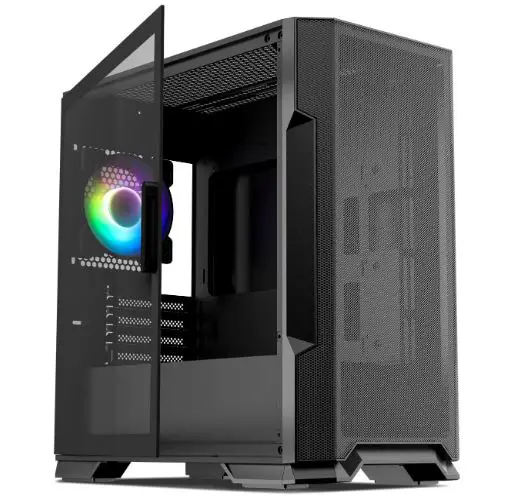
One of the standout features of the Vetroo M03 is the rear 120mm addressable RGB fan, which comes pre-installed. This fan not only enhances cooling performance but also adds a vibrant and customizable lighting effect, elevating the overall visual appeal of the case.
The case offers convenient accessibility with its door opening mechanism, allowing easy installation and maintenance of components. This feature streamlines the building process and simplifies cable management, resulting in a clean and organized interior.
With its compatibility with Micro ATX and Mini ITX motherboards, the Vetroo M03 allows users to choose their preferred form factor. This compatibility ensures that a wide range of high-performance hardware can be integrated into the system.
The Vetroo M03 prioritizes airflow optimization with its front mesh panel, enabling efficient cooling for demanding gaming sessions or resource-intensive tasks. Combining the front mesh panel and the pre-installed rear RGB fan creates a balanced airflow that keeps the components running smoothly.
In conclusion, the Vetroo M03 Compact Computer Case is the Best mid-range Micro ATX case. Its sleek design, tempered glass side panel, front mesh panel, pre-installed rear addressable RGB fan, door opening mechanism, and compatibility with Micro ATX and Mini ITX motherboards make it a remarkable choice for gamers and PC enthusiasts seeking both performance and aesthetics in their builds.
Pros:-
Sleek Design: The Vetroo M03 features a sleek and visually appealing design, with a tempered glass side panel and a front mesh panel, adding a touch of elegance to any build.
Pre-Installed Addressable RGB Fan: A rear 120mm addressable RGB fan enhances cooling performance and visual aesthetics, allowing for customizable lighting effects.
Convenient Accessibility: The door opening mechanism of the Vetroo M03 simplifies component installation and cable management, making it easier to build and maintain the system.
Compatibility: The case supports both Micro ATX and Mini ITX motherboards, allowing users to choose their preferred form factor and ensure compatibility with a wide range of hardware.
Optimized Airflow: The front mesh panel promotes excellent airflow, keeping the components cool and maintaining optimal performance during demanding tasks.
Cons:-
Limited Expansion Space: Due to its compact size, the Vetroo M03 may have limited space for expansion, which could restrict adding extra components or larger hardware.
Limited Fan Mounting Options: While the case comes with a pre-installed rear RGB fan, it may have limited options for additional fan installation, limiting customization possibilities for users who require more extensive cooling solutions.
Potential Cable Management Challenges: The compact design may result in limited space for cable management, requiring extra effort and planning to achieve a clean and organized interior.
Lack of Included Fans: Aside from the pre-installed rear RGB fan, the Vetroo M03 does not include additional fans, meaning users need to purchase and install extra fans for a more comprehensive cooling setup.
Considering these pros and cons allows users to decide whether the Vetroo M03 Compact Computer Case is the right choice for their specific needs and priorities.
Ideal User and Use Cases:-
The Vetroo M03 Micro ATX Case caters to users seeking style, performance, and flexibility.
Here are some ideal user profiles and use cases for this case:
Gamers and PC Enthusiasts: The Vetroo M03 is ideal for gamers and PC enthusiasts who prioritize aesthetics and performance. Its sleek design, tempered glass side panel, and addressable RGB fan create an immersive gaming experience.
Compact System Builders: Users looking to build a compact yet powerful system will appreciate the Vetroo M03. Its Micro ATX compatibility and efficient airflow design allow for a compact build without compromising performance.
Customization Enthusiasts: The Vetroo M03 provides flexibility for customization, making it a great choice for users who enjoy personalizing their builds. The pre-installed RGB fan and the tempered glass side panel create a foundation for adding additional lighting and unique component choices.
LAN Party Enthusiasts: The portable nature of the Vetroo M03, combined with its sleek design and efficient airflow, makes it suitable for users who frequently attend LAN parties or gaming events. Its compact form factor and easy accessibility contribute to its portability.
Content Creators and Professionals: Content creators and professionals who require a stylish and functional case will find the Vetroo M03 appealing. The efficient cooling and compatibility with high-performance components make it suitable for demanding tasks like video editing and 3D rendering.
Budget System Builders: Users on a budget who still want an aesthetically pleasing case can benefit from the Vetroo M03. Its affordable price point, sleek design, and tempered glass panel allow for an attractive build without sacrificing performance.
Overall, the Vetroo M03 Micro ATX Case caters to various users, including gamers, compact system builders, customization enthusiasts, LAN party enthusiasts, content creators, and budget system builders. Its style, performance, and flexibility make it an excellent choice for various use cases that prioritize aesthetics and functionality.
Check Price on Amazon6. ASUS Prime AP201
The ASUS Prime AP201 is a feature-packed and versatile MicroATX case that perfectly balances performance and functionality. Its tool-free side panels, quasi-filter mesh, and extensive component support make it an exceptional choice for discerning PC enthusiasts.
Designed conveniently, the ASUS Prime AP201 showcases tool-free side panels that make installation and maintenance a breeze—no need for additional tools or screws, saving time and effort for users.
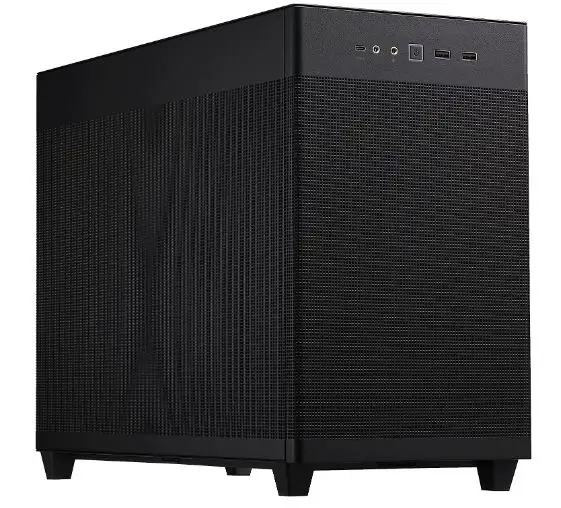
Including a quasi-filter mesh ensures optimal dust filtration, preventing unwanted particles from clogging the system. This feature promotes better cooling efficiency and prolongs the lifespan of internal components.
One of the key strengths of the ASUS Prime AP201 lies in its remarkable compatibility. It supports 360mm coolers, enabling enthusiasts to unleash the full potential of high-performance cooling solutions for overclocking and demanding tasks. Furthermore, the case accommodates graphics cards up to 338mm long, allowing powerful GPUs to deliver stunning visual experiences.
The ASUS Prime AP201 also supports standard ATX PSUs, providing users with flexibility and accessibility regarding power supply options.
With a 33-liter capacity, the case strikes an ideal balance between compactness and spaciousness. This makes it suitable for various builds, from compact gaming systems to multimedia workstations.
In conclusion, the ASUS Prime AP201 exemplifies the perfect blend of power and versatility. Its tool-free side panels, quasi-filter mesh, support for 360mm coolers, graphics cards up to 338mm long, and standard ATX PSUs make it an exceptional choice for PC enthusiasts seeking a MicroATX case that delivers outstanding performance and flexibility.
Pros:-
Tool-Free Side Panels: The tool-free side panels of the ASUS Prime AP201 make installation and maintenance hassle-free, saving time and effort for users.
Quasi-Filter Mesh: The quasi-filter mesh helps keep the system clean by effectively filtering dust particles, ensuring better cooling performance and prolonging the lifespan of internal components.
Support for 360mm Coolers: The case’s support for 360mm coolers allows users to utilize high-performance cooling solutions for efficient heat dissipation, ideal for overclocking or demanding tasks.
Graphics Card Compatibility: The ASUS Prime AP201 accommodates graphics cards up to 338mm in length, enabling users to install powerful GPUs that deliver immersive gaming experiences and handle graphics-intensive workloads.
Standard ATX PSU Support: The case’s support for standard ATX PSUs offers flexibility and compatibility with a wide range of power supply options.
Cons:-
Limited Radiator Support: While the case supports 360mm coolers, it may have limited radiator support for liquid cooling enthusiasts who prefer larger radiators or multiple radiator configurations.
Restricted Motherboard Size: The ASUS Prime AP201 only supports MicroATX motherboards, limiting the choice of form factors for users who prefer smaller or larger motherboards.
Potential Cable Management Challenges: Due to its compact size, the case may pose challenges for cable management, requiring extra effort and planning to achieve a clean and organized interior.
Lack of Included Fans: The ASUS Prime AP201 does not come with included fans, meaning users must purchase and install their preferred fans for optimal cooling performance.
Considering these pros and cons allows users to decide whether the ASUS Prime AP201 is the right choice for their specific needs and priorities.
Ideal User and Use Cases:-
The ASUS Prime AP201 caters to a range of users seeking a versatile and high-performance MicroATX case. Here are some ideal user profiles and use cases for this case:
PC Enthusiasts and Gamers: PC enthusiasts and gamers who demand powerful performance and cooling capabilities will find the ASUS Prime AP201 appealing. Its support for 360mm coolers and long graphics cards allows for high-performance components and overclocking potential.
Content Creators and Multimedia Professionals: Content creators and professionals working on multimedia projects will benefit from the ASUS Prime AP201. Its spacious interior accommodates powerful GPUs and allows for efficient cooling, making it suitable for handling graphics-intensive workloads.
Compact Workstations: The compact form factor of the ASUS Prime AP201, combined with its support for MicroATX motherboards, makes it an ideal choice for compact workstations. Users can build powerful and efficient workstations without sacrificing valuable desk space.
PC Builders with Custom Cooling Solutions: Users who prioritize custom cooling solutions, such as water cooling, will appreciate the ASUS Prime AP201’s support for 360mm coolers. It offers ample space and airflow potential for efficient and quiet cooling setups.
Versatile PC Builds: The ASUS Prime AP201’s compatibility with standard ATX PSUs and long graphics cards makes it suitable for various PC builds, including gaming rigs, multimedia stations, and home entertainment systems.
PC Builders Emphasizing Easy Maintenance: The tool-free side panels and quasi-filter mesh of the ASUS Prime AP201 streamline installation and maintenance processes, making it an excellent choice for users who prioritize easy accessibility and maintenance.
Overall, the ASUS Prime AP201 suits a diverse range of users, including PC enthusiasts, gamers, content creators, professionals, compact workstation builders, and those who prioritize custom cooling solutions.
Its versatility, compatibility, and performance-oriented features make it an excellent choice for various use cases that require power, flexibility, and efficient cooling.
Check Price on Amazon7. Fractal Design Node 804 – Best Cube Case
The Fractal Design Node 804 is a top-tier choice for cube Micro ATX cases. Its innovative design, efficient cooling capabilities, and exceptional build quality redefine what a cube case can offer.
The Fractal Design Node 804’s cube form factor provides a unique, compact layout that maximizes space efficiency while maintaining excellent hardware compatibility. It balances compactness and expansion possibilities, making it ideal for users who prioritize a small footprint without compromising performance.
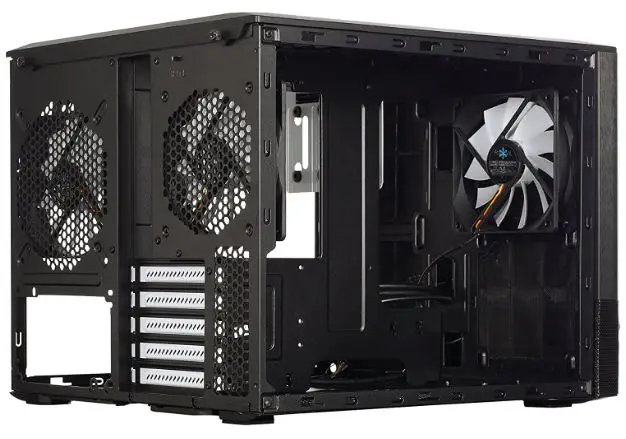
Equipped with multiple ventilated panels, the Node 804 ensures efficient airflow and optimal cooling for high-performance components. The cube case design allows separate chambers dedicated to the motherboard, storage, and power supply, minimizing heat interference and promoting effective cooling.
One of the standout features of the Fractal Design Node 804 is its impressive storage options. Users can build a storage powerhouse with support for up to ten hard drives or solid-state drives, making it perfect for media servers, NAS setups, or content creators who require extensive storage capacity.
The Node 804 also excels in ease of use with its tool-less drive bays and modular components. Installation and maintenance become effortless, allowing users to focus on building their system with minimal hassle.
The sleek and minimalistic design of the Fractal Design Node 804, combined with its durable build quality, makes it an aesthetically pleasing choice for any setup. Whether it’s a gaming rig, a home media center, or a professional workstation, the Node 804’s versatility makes it an excellent fit.
In conclusion, the Fractal Design Node 804 surpasses expectations as the best cube Micro ATX case. Its innovative cube form factor, efficient cooling design, extensive storage options, user-friendly features, and overall build quality make it an exceptional choice for users seeking a compact yet powerful case for their Micro ATX builds.
Pros:-
Compact and Efficient Design: The cube form factor of the Fractal Design Node 804 maximizes space efficiency while maintaining excellent hardware compatibility, making it perfect for users who prioritize a small footprint.
Excellent Cooling Performance: With its multiple ventilated panels and separate chambers for components, the Node 804 ensures efficient airflow and optimal cooling, even for high-performance systems.
Impressive Storage Capacity: The case supports up to ten hard or solid-state drives, providing extensive storage options for users requiring ample space for media storage or data-intensive tasks.
User-Friendly Features: The Node 804 incorporates tool-less drive bays and modular components, making installation and maintenance hassle-free, saving time and effort for users.
Sleek and Minimalistic Design: The Fractal Design Node 804 features a sleek and minimalistic design that adds an aesthetic appeal to any setup, blending well with various environments and styles.
Cons:-
Limited Expansion Slots: Due to its compact cube design, the Node 804 has limited expansion slots, which may restrict the ability to add extra components or expansion cards.
Limited GPU Length Support: While the case offers good hardware compatibility, the maximum supported length for graphics cards may be limited, potentially restricting the use of longer high-end GPUs.
Potential Cable Management Challenges: The cube form factor of Node 804 may pose challenges for cable management, requiring extra effort and planning to achieve a clean and organized interior.
Lack of Included Fans: The Fractal Design Node 804 does not come with included fans, meaning users must purchase and install their preferred fans for optimal cooling performance.
Considering these pros and cons allows users to decide whether the Fractal Design Node 804 Cube Micro ATX Case is the right choice for their specific needs and priorities.
Ideal User and Use Cases:-
The Fractal Design Node 804 Cube Micro ATX Case caters to users seeking a compact and efficient case.
Here are some ideal user profiles and use cases for this case:
Space-Conscious Enthusiasts: Users who value space efficiency and want a compact case without sacrificing hardware compatibility will find the Fractal Design Node 804 ideal. Its cube form factor allows for a smaller footprint, making it suitable for users with limited desk or room space.
Media and Data Storage Enthusiasts: The impressive storage capacity of the Node 804 makes it an excellent choice for users who require extensive storage options. It’s ideal for media servers, NAS setups, or professionals dealing with large amounts of data.
Multimedia Content Creators: Content creators working with multimedia projects like video editing or 3D rendering will appreciate Node 804’s efficient cooling design and hardware compatibility. Its separate chambers and ventilation ensure optimal cooling performance during resource-intensive tasks.
LAN Party Enthusiasts: The compact and portable nature of the Fractal Design Node 804 makes it suitable for LAN party enthusiasts. Its cube form factor and durable build quality allow for easy transportation and setup at gaming events.
Home Theater PC (HTPC) Builders: Users aiming to build a sleek and powerful Home Theater PC setup will find the Node 804 appealing. Its compact design and minimalist aesthetics blend well with home entertainment systems while providing sufficient hardware support for smooth multimedia playback.
System Builders Seeking Ease of Use: The user-friendly features, such as tool-less drive bays and modular components, make the Node 804 an excellent choice for system builders who prioritize ease of installation and maintenance.
Overall, the Fractal Design Node 804 Cube Micro ATX Case caters to a range of users, including space-conscious enthusiasts, media and data storage enthusiasts, content creators, LAN party enthusiasts, HTPC builders, and system builders seeking ease of use.
Its compact design, efficient cooling, impressive storage capacity, and versatile hardware compatibility make it ideal for various use cases prioritizing functionality and space optimization.
Check Price on Amazon8. Antec VSK10 – Best Value Option
The Antec VSK10 stands as a remarkable choice when it comes to a value-packed Micro ATX case. Its highly functional features, impressive cooling capabilities, and sleek aesthetics offer an exceptional combination of affordability and performance.
The Antec VSK10’s value proposition is evident in its feature set. Equipped with a window side panel, it showcases the internal components with style, allowing users to admire their hardware while adding a touch of sophistication to their build.
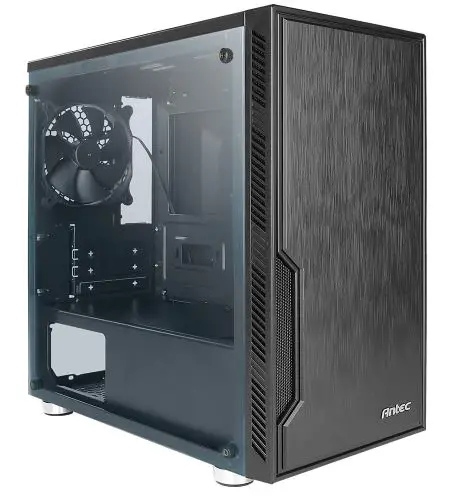
When it comes to cooling, the VSK10 doesn’t compromise. With support for 4 x 140mm fans and a 280mm radiator, users can achieve efficient cooling and maintain optimal temperatures even during intense gaming sessions or demanding workloads. This versatility in cooling options allows for customization based on individual preferences and system requirements.
Connectivity is not overlooked, as the VSK10 offers 2 x USB 3.0 ports on the front panel for fast and convenient data transfer. This ensures seamless connectivity with external devices and enhances the overall user experience.
The VSK10’s functionality extends to its internal design, providing ample space for hardware installation and cable management. The intelligently placed drive bays and routing channels contribute to a clean and organized interior, improving airflow and aesthetics.
With its sleek black exterior, the Antec VSK10 exudes a professional and timeless appeal, blending seamlessly with any setup or environment.
In conclusion, the Antec VSK10 exemplifies the best value micro ATX case concept. Its highly functional design, support for multiple fans and radiators, convenient front panel connectivity, spacious interior, and elegant aesthetics make it an excellent choice for users seeking an affordable yet high-performance case for their Micro ATX builds.
Pros:-
Affordable Value: The Antec VSK10 offers an excellent value proposition, providing a highly functional Micro ATX case at an affordable price.
Impressive Cooling Potential: With support for up to 4 x 140mm fans and a 280mm radiator, the VSK10 allows for efficient cooling, ensuring optimal temperatures even during demanding tasks or gaming sessions.
Window Side Panel: Including a window side panel allows users to showcase their internal components and adds a touch of style to the build.
Convenient Connectivity: The 2 x USB 3.0 ports on the front panel offer fast and convenient connectivity for external devices, enhancing the overall user experience.
Spacious Interior and Cable Management: The VSK10 provides ample space for hardware installation and includes routing channels for efficient cable management, resulting in a clean and organized interior.
Cons:-
Limited Expansion Options: Due to its compact Micro ATX form factor, the VSK10 may have limited expansion options compared to larger cases, potentially limiting the addition of extra components or expansion cards.
Potential Noise Levels: While the VSK10 offers impressive cooling capabilities, using multiple fans may result in higher noise levels than cases with advanced noise reduction features.
Limited Radiator Compatibility: Although the VSK10 supports a 280mm radiator, it may have limited options for larger radiator configurations or multiple radiator setups, limiting customization possibilities for users who require extensive liquid cooling solutions.
Lack of Included Fans: The Antec VSK10 does not have included fans, meaning users must purchase and install their preferred fans for optimal cooling performance.
Considering these pros and cons allows users to decide whether the Antec VSK10 Micro ATX Case is the right choice for their needs and priorities.
Ideal User and Use Cases:-
The Antec VSK10 Micro ATX Case caters to users seeking a value-oriented and functional case.
Here are some ideal user profiles and use cases for this case:
Budget-Conscious Builders: The Antec VSK10 is an excellent choice for users on a budget who still want a reliable and functional Micro ATX case. Its affordability and value-packed features make it ideal for cost-conscious builders.
Entry-Level Gamers: Entry-level gamers looking to build a compact and budget-friendly gaming system will find the Antec VSK10 appealing. Its cooling capabilities and spacious interior provide an adequate foundation for gaming components.
Home Office Workstations: Users needing a compact and functional case for their home office workstations will appreciate the Antec VSK10. It’s sleek design and convenient front panel connectivity suit professionals and remote workers who prioritize productivity.
Media Center Builds: The compact form factor and stylish aesthetics of the Antec VSK10 make it a great choice for building a media center PC. It can accommodate the necessary components for streaming media, playing movies, and providing entertainment in living room setups.
Casual System Builders: Casual system builders or DIY enthusiasts who enjoy building PCs will find the Antec VSK10 user-friendly and easy to work with. Its spacious interior, cable management features, and cooling potential provide a hassle-free building experience.
Secondary or Backup Systems: The Antec VSK10 suits users looking to build a secondary or backup system. It’s compact size and affordable price makes it a practical choice for setting up a system for specific tasks or as a backup for critical data.
Overall, the Antec VSK10 Micro ATX Case caters to diverse users, including budget-conscious builders, entry-level gamers, home office workers, media center enthusiasts, casual system builders, and users needing secondary or backup systems.
Its value-oriented features, compact design, and functional capabilities make it an ideal choice for various use cases that prioritize affordability and functionality.
Check Price on Amazon9. Thermaltake S100
The Thermaltake S100 is an exceptional choice for those seeking a best-in-class white Micro ATX case. Its sleek aesthetics, durable construction, and thoughtful features combine elegance with functionality to create a visually stunning, high-performance PC enclosure.
The Thermaltake S100’s white exterior exudes sophistication and purity, making it a standout piece in any setup. The tempered glass side panel showcases the internal components and adds a touch of elegance to the overall presentation, allowing users to admire their meticulously crafted builds.
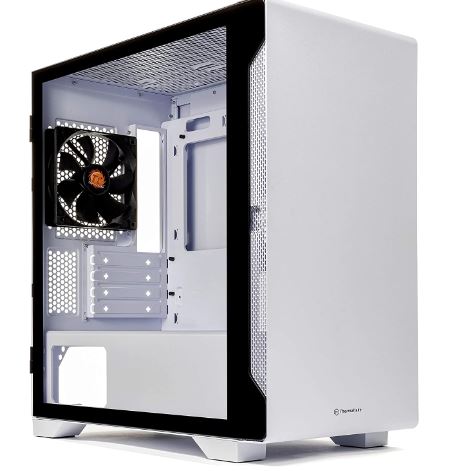
Built to impress, the S100 boasts a 120mm rear fan pre-installed for efficient airflow and improved cooling performance. This ensures the system remains at optimal temperatures, even during demanding tasks or gaming sessions.
The case’s compact micro ATX form factor optimizes space efficiency without compromising hardware compatibility. It supports a range of components, including graphics cards up to 330mm in length, providing users with the flexibility to build powerful systems within a smaller footprint.
The Thermaltake S100 excels in cable management with its strategically placed routing channels and ample space behind the motherboard tray. This allows for clean and tidy cable organization, improving airflow and aesthetics.
Additionally, the S100 offers convenient front panel USB ports for easy accessibility and connectivity, ensuring seamless interaction with external devices.
In conclusion, the Thermaltake S100 earns its reputation as the best white Micro ATX case with its exquisite design, durable construction, and practical features.
It delivers a harmonious blend of elegance and functionality, making it an excellent choice for users who seek a visually striking and high-performance case for their Micro ATX builds.
Pros:-
Sleek and Elegant Design: The Thermaltake S100 features a white exterior and a tempered glass side panel, providing a visually stunning and elegant appearance that enhances the overall aesthetic of any build.
Durable Construction: The case is built with high-quality materials, ensuring durability and longevity, making it a reliable choice for long-term use.
Efficient Cooling: The pre-installed 120mm rear fan promotes efficient airflow and helps maintain optimal temperatures for the components, ensuring reliable performance even during intense gaming or demanding workloads.
Compact Form Factor: The micro ATX form factor of the S100 optimizes space efficiency, making it suitable for users who want a smaller footprint without compromising on hardware compatibility.
Cable Management: The case provides ample space and strategically placed routing channels for effective cable management, allowing for a clean, organized interior and improved airflow.
Cons:-
Limited Expansion Options: Due to its compact size, the S100 may have limited expansion options compared to larger cases, which could restrict adding extra components or expansion cards.
Limited Cooling Support: While the case includes a pre-installed rear fan, it may have limited support for additional fans or larger cooling solutions, limiting customization options for users who require advanced cooling configurations.
Lack of Included Fans: The Thermaltake S100 may not have additional fans, requiring users to purchase and install additional cooling fans for optimal airflow and cooling performance.
Potential Cable Management Challenges: Despite its cable management features, the compact size of the S100 may present challenges in managing cables, requiring careful planning and organization to achieve a tidy interior.
Considering these pros and cons allows users to decide whether the Thermaltake S100 White Micro ATX Case meets their specific needs and preferences.
Ideal User and Use Cases:-
The Thermaltake S100 White Micro ATX Case is designed to cater to users seeking a combination of elegance and functionality in a compact form factor.
Here are some ideal user profiles and use cases for this case:
Aesthetics-Conscious Builders: Users who prioritize aesthetics and want to create visually stunning builds will find the Thermaltake S100 appealing. Its sleek white design and tempered glass side panel add an elegant touch to any setup.
Space-Conscious Enthusiasts: The compact micro ATX form factor of the S100 makes it an excellent choice for users with limited desk or room space. It offers a smaller footprint without compromising on hardware compatibility.
Entry-Level Gamers: Entry-level gamers looking for a stylish and functional case for their gaming system will appreciate the Thermaltake S100. Its efficient cooling and support for long graphics cards make it suitable for entry-level gaming builds.
Home Office and Productivity: Users needing a compact and visually appealing case for their home office or productivity workstation will find the S100 suitable. Its sleek design blends well with professional environments, enhancing productivity and style.
Multimedia and HTPC Setups: The Thermaltake S100’s compact size and elegant aesthetics make it a great choice for building media center PCs or Home Theater PC (HTPC) setups. Its compact form factor can fit seamlessly into living room entertainment systems.
System Builders with Cable Management Focus: The S100’s cable management features, such as routing channels and ample space, make it ideal for system builders prioritizing clean and organized interiors. It allows for tidy cable management and improved airflow.
Overall, the Thermaltake S100 White Micro ATX Case caters to a range of users, including aesthetics-conscious builders, space-conscious enthusiasts, entry-level gamers, home office workers, multimedia and HTPC enthusiasts, and system builders focusing on cable management.
Its elegant design, compact form factor, efficient cooling, and hardware compatibility make it suitable for various use cases prioritizing style, functionality, and space optimization.
Check Price on Amazon10. CORSAIR CRYSTAL 280X
The CORSAIR CRYSTAL 280X is the epitome of excellence in micro ATX cases. Its stunning aesthetics, advanced RGB lighting, exceptional build quality, and thoughtful features redefine what a micro ATX case can offer.
The CORSAIR CRYSTAL 280X’s standout feature is its tempered glass panels that showcase the internal components with unrivaled elegance. The sleek black exterior, combined with the crystal-clear tempered glass, creates a visually stunning presentation that adds a touch of sophistication to any build.
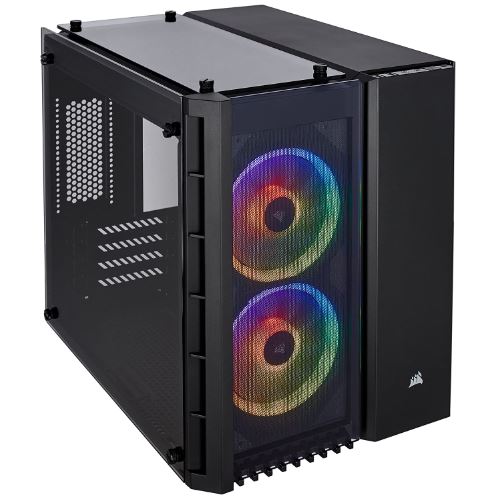
Enhancing the visual appeal further, the case has two RGB fans and a Lighting Node PRO, allowing users to customize their lighting effects and create a personalized and immersive experience. The advanced RGB lighting system transforms the case into a work of art, setting the perfect ambiance for gaming or showcasing a unique style.
Beyond aesthetics, the CRYSTAL 280X excels in functionality. Its dual-chamber design separates the power supply, drives, and cables from the main components, ensuring clean and efficient airflow for optimal cooling performance.
The case provides ample space for high-end hardware, including long graphics cards and multiple storage options. It enables users to build powerful and versatile systems within its compact micro ATX form factor.
Additionally, the CRYSTAL 280X features convenient cable management solutions, such as routing channels and Velcro straps, allowing for a clean and organized interior. This not only improves aesthetics but also enhances airflow and ease of maintenance.
In conclusion, the CORSAIR CRYSTAL 280X surpasses expectations as the best micro ATX case. Its stunning aesthetics, advanced RGB lighting, exceptional build quality, dual-chamber design, and convenient cable management features make it an extraordinary choice for users who seek a blend of style, functionality, and performance in their micro ATX builds.
Pros:-
Stunning Aesthetics: The CORSAIR CRYSTAL 280X features a sleek black exterior and tempered glass panels that create a visually stunning and sophisticated look, enhancing the overall aesthetic of any build.
Advanced RGB Lighting: With two included RGB fans and the Lighting Node PRO, the case offers advanced RGB lighting capabilities, allowing users to customize and personalize their lighting effects for a captivating and immersive experience.
Exceptional Build Quality: The case is built with high-quality materials, ensuring durability and longevity, making it a reliable choice for long-term use.
Dual-Chamber Design: The CRYSTAL 280X’s dual-chamber design separates the power supply, drives, and cables from the main components, promoting efficient airflow and optimal cooling performance.
Versatile Hardware Support: Despite its compact micro ATX form factor, the case provides ample space for high-end hardware, including long graphics cards and multiple storage options, enabling users to build powerful and versatile systems.
Cons:-
Limited Radiator Compatibility: The case may have limited support for larger radiator configurations or multiple radiator setups, which could restrict customization options for users who require extensive liquid cooling solutions.
Potential Cable Management Challenges: While the case offers cable management solutions, the compact size of the CRYSTAL 280X may present challenges in managing cables, requiring careful planning and organization to achieve a tidy interior.
Price: Compared to other micro ATX cases, the CORSAIR CRYSTAL 280X is positioned at a higher price point, which may be a consideration for budget-conscious users.
Potential Noise Levels: Depending on the chosen components and fan configuration, the case may produce higher noise levels due to its focus on aesthetics and airflow.
Considering these pros and cons allows users to decide whether the CORSAIR CRYSTAL 280X Micro ATX Case aligns with their specific needs and priorities.
Ideal User and Use Cases:-
The CORSAIR CRYSTAL 280X Micro ATX Case caters to users who value aesthetics and performance in their PC builds. Here are some ideal user profiles and use cases for this case:
PC Enthusiasts and Modders: The CORSAIR CRYSTAL 280X is an ideal choice for PC enthusiasts and modders who prioritize aesthetics and want to create visually stunning and unique builds. Its tempered glass panels, advanced RGB lighting, and sleek design allow impressive customization and showcase opportunities.
Gaming Enthusiasts: Gamers seeking a compact yet powerful system will appreciate the CRYSTAL 280X. Its spacious interior accommodates high-end hardware, including long graphics cards, making it suitable for gaming setups with exceptional performance.
Content Creators: The case’s dual-chamber design and versatile hardware support make it a great option for content creators. It provides sufficient space for storage drives, offering ample room for media files, while its cooling capabilities ensure optimal performance during resource-intensive tasks.
Showpiece Builds: The CRYSTAL 280X is perfect for users who want to showcase their builds at events, exhibitions, or social media. Its stunning aesthetics and advanced RGB lighting allow for eye-catching and attention-grabbing presentations.
PC Builders with Cable Management Focus: Users prioritizing clean and organized interiors will appreciate CRYSTAL 280X’s cable management solutions. Its routing channels and Velcro straps help achieve a neat build, enhancing aesthetics and airflow.
Home Office and Workspace Builds: The sleek design and professional aesthetics of the CRYSTAL 280X make it an excellent choice for users who want a visually appealing case for their home office or workspace. Its compact form factor allows for efficient use of space without sacrificing performance.
Overall, the CORSAIR CRYSTAL 280X Micro ATX Case is ideal for PC enthusiasts, gaming enthusiasts, content creators, showpiece builders, users focusing on cable management, and individuals looking to enhance the visual appeal of their home office or workspace.
Its stunning aesthetics, versatile hardware support, and advanced RGB lighting capabilities make it a top choice for users seeking a balance of style and performance in their micro ATX builds.
Check Price on Amazon11. Thermaltake Level 20 VT
The Thermaltake Level 20 VT represents a paradigm shift in micro ATX cases with its innovative design and unmatched modularity. Its interchangeable panels, DIY LCS chamber concept, and tempered glass aesthetics set a new standard for customization and versatility.
The Level 20 VT’s key feature is its interchangeable panel design, which allows users to switch between various panels for different configurations and aesthetics. Whether a full-tempered glass panel to showcase the internal components or a solid panel for optimized airflow, the Level 20 VT empowers users to adapt their case to their specific needs.
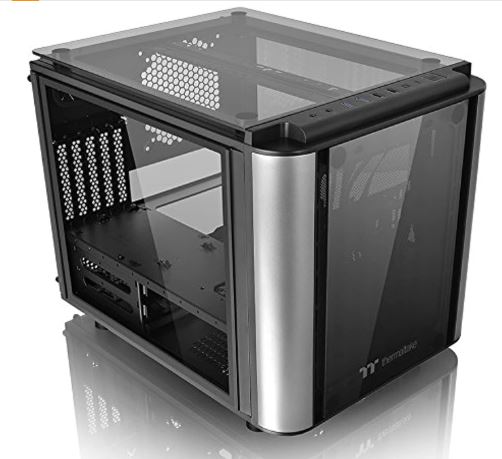
Built upon the DIY LCS chamber concept, the Level 20 VT integrates a dedicated liquid cooling compartment that separates the liquid cooling components from the rest of the system. This design ensures efficient cooling performance and simplifies maintenance and upgrades for liquid cooling enthusiasts.
The tempered glass side panel adds a touch of elegance and enables users to admire their custom loop cooling setups or high-end hardware configurations. It’s a true spectacle for enthusiasts who take pride in their PC builds.
Regarding hardware compatibility, the Level 20 VT offers ample space for high-end components, including long graphics cards and large radiators. The modular drive cage design allows for easy installation and expansion of storage options, catering to users requiring extensive storage capacity.
Furthermore, the Level 20 VT emphasizes convenient accessibility with its I/O ports on the top panel, providing easy connectivity for USB devices and audio peripherals.
In conclusion, the Thermaltake Level 20 VT sets a new benchmark for micro ATX cases with its groundbreaking modularity and design. It offers unparalleled customization options, a dedicated liquid cooling chamber, tempered glass aesthetics, and versatile hardware compatibility.
The Level 20 VT is a testament to Thermaltake’s commitment to empowering users to unleash their creativity and build a truly unique and personalized PC experience.
Pros:-
Interchangeable Panel Design: The Level 20 VT’s interchangeable panel design allows users to easily switch between different panels for customized configurations and aesthetics, providing flexibility and adaptability.
DIY LCS Chamber Concept: The dedicated liquid cooling compartment separates the liquid cooling components from the rest of the system, ensuring efficient cooling performance and simplified maintenance and upgrades for liquid cooling enthusiasts.
Tempered Glass Aesthetics: The tempered glass side panel adds a touch of elegance and allows users to showcase their custom loop cooling setups or high-end hardware configurations, enhancing the overall visual appeal of the build.
Versatile Hardware Compatibility: The Level 20 VT offers ample space for high-end components, including long graphics cards and large radiators, making it suitable for users who require powerful hardware configurations.
Modular Drive Cage Design: The modular drive cage design allows for easy installation and expansion of storage options, catering to users who need extensive storage capacity.
Cons:-
Bulky Form Factor: The Level 20 VT has a larger footprint than standard micro ATX cases, which may not be suitable for users with a limited desk or space availability.
Complex Assembly Process: The modularity and interchangeable panel design may result in a more complex assembly process than traditional micro ATX cases, requiring careful planning and attention to detail during the build.
Limited Airflow with Solid Panels: When using solid panels for optimized airflow, the Level 20 VT may experience reduced airflow compared to cases with mesh front panels, potentially impacting overall cooling performance.
Higher Price Point: The Level 20 VT’s advanced features and modularity come at a higher price point than standard micro ATX cases, which may be a consideration for budget-conscious users.
Considering these pros and cons allows users to evaluate whether the Thermaltake Level 20 VT Micro ATX Case aligns with their needs and preferences.
Ideal User and Use Cases:-
The Thermaltake Level 20 VT Micro ATX Case caters to a specific set of users who value customization, modularity, and advanced liquid cooling capabilities. Here are some ideal user profiles and use cases for this case:
Enthusiast Builders and Modders: The Level 20 VT is ideal for PC enthusiasts and modders seeking a highly customizable and visually striking case. Its interchangeable panel design allows endless customization options, enabling users to create unique and personalized builds.
Liquid Cooling Enthusiasts: Users passionate about custom loop liquid cooling systems will appreciate Level 20 VT’s dedicated liquid cooling chamber. The separate compartment simplifies installation, maintenance, and upgrades of liquid cooling components, offering an optimized environment for efficient cooling.
Showcase Builds and Exhibitions: The Level 20 VT’s tempered glass aesthetics and interchangeable panel design make it a perfect choice for users who want to showcase their builds at events, exhibitions, or social media. Its striking visuals and advanced modularity allow for eye-catching and attention-grabbing presentations.
High-Performance Gaming Systems: Gamers seeking a powerful micro ATX gaming system with advanced cooling capabilities will find the Level 20 VT suitable. Its spacious interior, versatile hardware compatibility, and dedicated liquid cooling chamber offer the potential for high-end gaming setups.
Content Creators and Workstations: The Level 20 VT’s ample space and modularity make it a great option for content creators and workstation users. It accommodates high-performance hardware and offers sufficient storage options, making it suitable for tasks that require extensive processing power and storage capacity.
Experienced PC Builders: The Level 20 VT’s advanced features, modularity, and customizable options make it a preferred choice for experienced PC builders who enjoy the challenge of intricate assembly processes and want to push the boundaries of their builds.
Overall, the Thermaltake Level 20 VT Micro ATX Case caters to enthusiasts, modders, liquid cooling enthusiasts, showcase builders, gamers, content creators, workstation users, and experienced PC builders.
Its customization options, liquid cooling capabilities, and versatility make it ideal for users who prioritize modularity and advanced cooling in their micro ATX builds.
Check Price on AmazonUnderstanding Compatibility with Other Components
When building a PC, ensuring all components work harmoniously is essential. One critical aspect to consider is the compatibility of a micro-ATX case with other components. Understanding this compatibility ensures a seamless and efficient build.
Let’s delve into the factors that influence micro-ATX case compatibility.
Motherboard Compatibility: The micro-ATX case is designed to house a micro-ATX motherboard, a smaller form factor than standard ATX. Verifying that the case supports micro-ATX motherboards is crucial to ensure a proper fit. Some micro-ATX cases may also accommodate mini-ITX motherboards, offering even more flexibility.
Graphics Card Clearance: Checking the graphics card clearance is essential, especially for gamers and graphic-intensive tasks. Micro-ATX cases typically have limited space for longer graphics cards. Ensure the case provides sufficient clearance to accommodate your chosen graphics card, preventing fitment issues.
Cooling System Compatibility: Efficient cooling is vital to maintain optimal component temperatures. Micro-ATX cases come with pre-installed fans and support for additional cooling solutions. Ensure that the case has adequate fan mounts, radiator support, and clearance for CPU coolers to ensure proper cooling efficiency.
Storage Options: Consider the storage options provided by the micro-ATX case. It should support the number and type of storage devices you plan to use, such as HDDs, SSDs, or M.2 drives. Check for drive bays, mounting brackets, and compatibility with various storage sizes.
Power Supply Compatibility: The power supply unit (PSU) is critical to any PC build. Ensure that the micro-ATX case can accommodate your chosen PSU form factor, typically ATX or SFX. Verify the PSU clearance and mounting options to ensure a proper and secure fit.
Expansion Slots: Micro-ATX cases offer a limited number of expansion slots compared to full-sized ATX cases. Consider the number of expansion slots needed for your intended use, such as dedicated graphics cards, sound cards, or Wi-Fi cards. Verify that the case provides sufficient expansion slots to meet your requirements.
By understanding micro-ATX case compatibility with other components, you can make informed decisions when selecting and assembling your PC build. Ensure that the case supports your chosen motherboard, graphics card, cooling system, storage devices, power supply, and expansion needs.
This attention to compatibility guarantees a smooth and successful building experience, resulting in a high-performance and reliable system.
How to Install Components in a Micro ATX Case
Installing components in a micro ATX case requires careful planning and attention to detail. With the right approach, you can create a powerful and compact system.
Follow these steps to install components in your micro ATX case successfully.
1. Prepare Your Work Area
Before you start, ensure you have a clean and well-lit work area. Gather all the necessary tools, such as a screwdriver, cable ties, and thermal paste. Also, consult the user manuals for your components to familiarize yourself with their installation requirements.
2. Install the Motherboard
Begin by installing the motherboard into the micro ATX case. Align the motherboard’s I/O shield with the corresponding cutout in the case and gently slide it in. Secure the motherboard using screws, ensuring it’s level and properly seated.
3. Install the CPU and CPU Cooler
Next, install the CPU into the motherboard’s socket. Lift the retention arm, align the CPU notches with the socket markers, and gently lower it into place. Apply a small amount of thermal paste on the CPU, then attach the CPU cooler following the manufacturer’s instructions. Secure it firmly but avoid overtightening.
4. Install Memory (RAM)
Insert the memory modules (RAM) into the appropriate slots on the motherboard. Align the notch on the module with the key in the slot and press it down firmly until it clicks into place. Ensure the locking tabs on both sides are fully engaged.
5. Install Storage Devices
Install your storage devices, such as SSDs or HDDs, into the designated drive bays. Secure them using screws or tool-less mounting systems depending on your case’s design. Connect the data and power cables to the drives and route them neatly to avoid obstructing airflow.
6. Install the Power Supply Unit (PSU)
Place the power supply unit into the PSU chamber, aligning it with the mounting holes. Secure it in place using screws. Connect the necessary power cables to the motherboard, graphics card, and storage devices. Route the cables neatly and use cable ties to manage excess cables for improved airflow and aesthetics.
7. Install Expansion Cards
If you have expansion cards, such as graphics or sound cards, install them into the appropriate PCIe slots on the motherboard. Ensure they are securely seated and fasten them with screws if necessary. Connect any necessary power cables or additional connectors required by the expansion cards.
8. Connect Front Panel Connectors
Locate the front panel connectors on the motherboard and connect the power switch, reset switch, HDD LED, power LED, and any other connectors your case supports. Refer to the motherboard’s manual for the correct pinout configuration.
9. Finalize Cable Management
Take the time to route and manage your cables neatly. Use cable ties or Velcro straps to secure them along designated cable management channels or tie-down points. Proper cable management improves airflow and aesthetics while making future maintenance easier.
10. Test the System
Double-check all connections and ensure everything is securely in place. Connect the power cable and peripherals, then power on your system. Check for any error messages or abnormal behavior during the boot process. If all is well, install the operating system and necessary drivers.
Following these steps, you can install components in a micro ATX case. Remember to take your time, be patient, and refer to each component’s user manuals and instructions. Your micro ATX build will provide a powerful and efficient computing experience with proper installation.
Maintenance and Upgrading
Micro ATX cases are compact and efficient, but like any PC component, they require regular maintenance and occasional upgrades to ensure optimal performance and longevity. Here are some helpful tips on maintaining and cleaning your Micro ATX case and a guide on upgrading components.
Maintaining and Cleaning Micro ATX Cases:-
Dust Prevention: Place your Micro ATX case in a clean, well-ventilated area away from dust-prone environments. Consider using dust filters on intake fans to minimize dust buildup inside the case.
Regular Cleaning: Turn off your PC and unplug it from the power source every few months or as needed. Compressed air or a soft brush removes dust from the case fans, vents, and components. Be careful not to damage any delicate parts.
Component Inspection: Periodically check the connections, cables, and components inside the case. Ensure everything is secure and free from any signs of damage or wear.
Cable Management: Maintain good cable management by routing cables neatly and using cable ties or Velcro straps to secure them. Proper cable management improves airflow, reduces clutter, and makes future maintenance easier.
Fan Maintenance: Keep the case fans clean and in good working condition. If a fan becomes noisy or fails, consider replacing it promptly to ensure proper airflow and cooling.
Temperature Monitoring: Monitor the temperatures of your components using software utilities or hardware monitoring devices. High temperatures can cause performance issues and potentially damage components. If temperatures are consistently high, consider adjusting fan speeds, improving airflow, or upgrading cooling solutions.
Upgrading Components in a Micro ATX Case:
Determine Compatibility: Before upgrading any component, ensure it is compatible with your Micro ATX case and motherboard. Check factors such as form factor, clearance, and power requirements.
Plan Your Upgrades: Identify the components you want to upgrade, such as the CPU, graphics card, or storage. Research the performance gains and compatibility of the new components.
Prepare Your Workspace: Turn off your PC, unplug it from the power source, and ground yourself to discharge any static electricity. Place your PC on a clean and static-free surface.
Follow Safety Precautions: When working inside your PC, handle components carefully, avoiding static discharge or physical damage. Refer to component manuals or online resources for specific installation instructions.
Upgrade Process: Start by disconnecting cables and removing the side panel of your Micro ATX case. Replace the old component with the new one, ensuring proper alignment and connection. Secure the component using screws or other mounting mechanisms as necessary.
Test and Update: After upgrading a component, reconnect all cables, including power and data connections. Power on your PC and check if the system recognizes and functions with the new component. Update drivers and software as needed.
Remember, if you are unsure about any aspect of maintenance or component upgrades, consult professional assistance or refer to the manufacturer’s documentation. Your Micro ATX case can provide years of reliable, high-performance computing with proper maintenance and thoughtful upgrades.
📗FAQ’s
What is the best case for a Micro ATX motherboard?
The best case for a Micro ATX motherboard depends on individual preferences and requirements. Some popular options include the Fractal Design Define Mini C, Cooler Master MasterBox Q300L, and Corsair Carbide Series Air 240.
Is a Micro ATX case good?
Yes, Micro ATX cases are excellent choices for those seeking a compact and space-saving form factor without compromising functionality. They offer sufficient room for essential components, often with features such as efficient cable management and adequate cooling options.
Are Micro ATX motherboards better?
Micro ATX motherboards offer a balance between compactness and expandability. While they may have fewer PCIe slots and limited space for components compared to ATX motherboards, they can still deliver reliable performance for most applications.
What case fits a Micro ATX?
Micro ATX motherboards fit into Micro ATX cases designed specifically for this form factor. These cases are slightly larger than Mini-ITX cases but smaller than standard ATX cases, providing a suitable form factor for Micro ATX motherboards.
Why are Micro ATX cases cheaper?
Micro ATX cases are often cheaper than larger form factor cases because they use less material and have fewer features. The smaller size also contributes to lower manufacturing and shipping costs.
Are Micro ATX motherboards worse than ATX?
Micro ATX motherboards are not inherently worse than ATX motherboards. They offer similar functionality and performance but with a smaller form factor. The choice between the two depends on the specific needs and preferences of the user.
Is a Micro ATX bad?
No, Micro ATX is not bad. It is a reliable and popular form factor that balances size and functionality well. Micro ATX systems can be suitable for various use cases, including gaming, home theater PCs, and office setups.
Are there disadvantages to Micro ATX?
One potential disadvantage of Micro ATX is the limited expansion options due to the smaller form factor. They have fewer PCIe slots, memory slots, and storage connectors compared to larger form factors like ATX. However, for most users, these limitations are not a significant issue.
Why choose ATX over Micro ATX?
ATX over Micro ATX provides expansion options, including additional PCIe slots, memory slots, and storage connectors. ATX motherboards are suitable for users who require extensive customization and multiple expansion cards.
Why are expensive motherboards better?
Expensive motherboards offer additional features, better power delivery, enhanced cooling capabilities, and more robust build quality. They are designed for enthusiasts and professionals who demand top-tier performance and overclocking capabilities.
Are Micro ATX cases cheaper?
Micro ATX cases can be cheaper than larger form factor cases due to their smaller size and simplified designs. However, pricing can vary based on brand, features, and build quality.
Can a 3-fan GPU fit in a Micro ATX?
Yes, many Micro ATX cases can accommodate 3-fan GPUs. However, it is important to check the GPU length compatibility specified by the case manufacturer to ensure a proper fit.
Can Micro ATX fit in a mid-tower?
Yes, Micro ATX motherboards can fit in mid-tower cases. Mid-tower cases are designed to support various motherboard form factors, including Micro ATX, ATX, and sometimes even larger form factors like E-ATX.
Why is MITX so expensive?
Mini-ITX (MITX) motherboards are often more expensive due to their smaller form factor, which requires specialized engineering and design to fit the same level of functionality into a compact layout. Additionally, the demand for Mini-ITX motherboards is generally lower, contributing to higher prices.
Do all cases support Micro ATX?
No, not all cases support Micro ATX. It is important to check the specifications and compatibility of a case to ensure it can accommodate a Micro ATX motherboard.
What is the most common motherboard size?
ATX (Advanced Technology eXtended) is desktop PCs’ most common motherboard size. It offers a good balance between expandability and compatibility.
What are the disadvantages of ATX?
ATX motherboards and cases are larger, which may limit their use in compact or portable builds. They also require more space in PC setups and may be slightly more expensive than smaller form factors.
What does ATX stand for?
ATX stands for Advanced Technology eXtended, a motherboard form factor specification developed by Intel in the 1990s. It defines the motherboard’s physical dimensions, layout, and power connections.
Is ATX obsolete?
No, ATX is not obsolete. It continues to be widely used and supported in the PC industry. However, smaller form factors like Micro ATX and Mini-ITX have gained popularity due to their compactness and flexibility.
Is ATX cooler than Micro ATX?
There is no inherent difference in cooling performance between ATX and Micro ATX motherboards. Cooling performance primarily depends on factors such as the case design, airflow, and the efficiency of cooling components like fans and CPU coolers.
What are the disadvantages of a Mini-ITX motherboard?
Mini-ITX motherboards have limited expansion options, including fewer PCIe slots, memory slots, and SATA connectors. The smaller form factor can also increase temperatures without proper cooling.
What is LPX motherboard?
LPX (Low-Profile eXtension) is a form factor for motherboards typically used in slim and low-profile systems. LPX motherboards are designed to be more compact and are often found in specialized builds.
Does it matter if I get a cheap motherboard?
Getting a cheap motherboard may result in limitations in terms of features, expansion options, build quality, and overclocking potential. However, if the motherboard meets your needs and budget, it can still provide reliable performance.
What is the smallest ATX case in the world?
The SilverStone Sugo SG13 is considered one of the smallest ATX cases available. Despite its compact size, it can still accommodate an ATX power supply and full-size graphics card.
What is bigger than Micro ATX?
ATX is a larger form factor than Micro ATX. It offers more expansion slots, memory slots, and connectivity options. E-ATX (Extended ATX) is larger than ATX and provides additional space for multiple graphics cards and storage devices.
Is Mini-ITX more expensive than Micro ATX?
Mini-ITX motherboards can be more expensive than Micro ATX due to their compact design and specialized components. Mini-ITX motherboards require careful engineering to fit the same level of functionality into a smaller form factor.
Can the RTX 2060 fit in Micro ATX?
Yes, the RTX 2060 can fit in most Micro ATX cases, but it is essential to check the GPU length compatibility specified by the case manufacturer to ensure a proper fit.
Can Micro ATX fit the RTX 3060?
Yes, the RTX 3060 can fit in most Micro ATX cases as long as the case has sufficient clearance for the length of the graphics card.
Can the RTX 3080 fit in Micro ATX?
The RTX 3080 is a larger graphics card, and its compatibility with a Micro ATX case depends on its specific dimensions and clearance. It is advisable to check the GPU length compatibility specified by the case manufacturer.
Is Mini tower the same as Micro-ATX?
No, a mini tower refers to a PC case’s size and form factor, while Micro ATX refers to the size and form factor of a motherboard. A mini tower case can support various motherboard form factors, including Micro ATX, Mini-ITX, and sometimes ATX.
Does Micro ATX fit in Mini-ITX?
No, Micro ATX does not fit in Mini-ITX cases. Mini-ITX cases are designed specifically for the Mini-ITX form factor, smaller than Micro ATX.
Should I get full ATX or mid ATX?
The choice between full ATX and mid-ATX depends on your specific needs and preferences. Full ATX offers more expansion options and connectivity, while mid-ATX provides a more compact form factor without sacrificing essential functionality.
Is MITx Pro free?
MITx Pro refers to professional courses offered by MITx, the online learning initiative of the Massachusetts Institute of Technology (MIT). These courses are not free and typically require enrollment fees.
Is MIT the same as MITx?
MIT (Massachusetts Institute of Technology) is a renowned institution, while MITx is the online learning platform developed by MIT to offer courses to a wider audience.
What is the smallest motherboard?
The Mini-ITX form factor is the smallest commonly available motherboard size. It measures 170mm x 170mm and offers a compact layout for space-constrained builds.
How big is a MicroATX case in CM?
Micro ATX cases typically measure around 24cm x 24cm x 35cm (W x D x H) or 9.4 inches x 9.4 inches x 13.8 inches.
Are all MicroATX motherboards the same?
No, Micro ATX motherboards can vary in features, layout, and connectivity options. Different manufacturers offer different models with varying specifications to cater to a wide range of needs.
What is the advantage of Micro ATX?
Micro ATX offers a compact form factor ideal for smaller PC builds. It balances size and functionality, making it suitable for various applications.
What is the advantage of an mATX motherboard?
The advantages of an mATX motherboard include its compact size, lower cost compared to larger form factors, and compatibility with a wide range of components. It is a popular choice for smaller PC builds.
Are ATX motherboards good for gaming?
ATX motherboards are suitable for gaming as they provide ample expansion slots for multiple graphics cards, support for high-performance CPUs, and additional features such as improved audio and networking capabilities.
What does MATX stand for?
MATX is an abbreviation for Micro ATX, a smaller form factor for motherboards and cases.
Why is ATX important?
ATX is important because it standardized motherboard sizes, layouts, and power supply connections, allowing for compatibility and interchangeability between components.
Is microATX worse than ATX?
Micro ATX is not inherently worse than ATX. While it offers fewer expansion options due to its smaller size, it still provides adequate functionality for most users’ needs.
Is there a downside to Micro ATX?
The main downside of Micro ATX is the limited expansion options compared to larger form factors. Micro ATX motherboards have fewer PCIe slots, memory slots, and storage connectors. However, for many users, these limitations are not significant drawbacks.
Do Micro ATX cases get hotter?
Micro ATX cases do not necessarily get hotter than other case sizes. Proper airflow and cooling solutions, including adequate fan placement and CPU cooler selection, are crucial for maintaining optimal temperatures regardless of the case size.
What advantages does ATX have over Micro ATX?
ATX offers more expansion options with additional PCIe slots, memory slots, and storage connectors than Micro ATX. This makes ATX more suitable for users who require extensive customization and multiple expansion cards.
Why is Mini ATX so expensive?
Mini-ITX motherboards are often more expensive due to their compact size, which requires specialized engineering and design. The smaller form factor necessitates careful component placement and layout to fit the same level of functionality.
What is the disadvantage of a small PC case?
A disadvantage of a small PC case is limited space for expansion and cooling options. Smaller cases may have fewer drive bays, limited GPU clearance, and reduced airflow, impacting component compatibility and thermal management.
Can I put an ATX motherboard in a Mini ATX case?
No, an ATX motherboard cannot fit in a Mini-ITX case. Mini-ITX cases are designed specifically for the Mini-ITX form factor, which is smaller than ATX.
What is H and B in a motherboard?
H and B refer to different series or segments within a motherboard lineup. For example, in the Intel chipset series, H generally represents the mainstream segment, while B represents the business or budget segment.
What does LPX stand for?
LPX stands for Low-Profile eXtension, a motherboard form factor designed for slim and low-profile systems.
Is Micro ATX the smallest?
No, Micro ATX is not the smallest motherboard form factor. It is larger than Mini-ITX and Nano-ITX, which are even more compact options.
What is the smallest ATX case with a full-size GPU?
The DAN Cases A4-SFX is one of the smallest ATX cases capable of accommodating a full-size GPU while maintaining a compact form factor.
What is the maximum size of Micro ATX?
Micro ATX motherboards typically measure 244mm x 244mm (9.6 inches x 9.6 inches), the standardized size for this form factor.
Is mATX better than ATX?
“MATX” is a common abbreviation for Micro ATX, which is smaller than ATX. The choice between the two depends on the specific requirements and preferences of the user.
What is the disadvantage of Mini-ITX?
A disadvantage of Mini-ITX is the limited expansion options due to its small form factor. Mini-ITX motherboards generally offer fewer PCIe slots, memory slots, and storage connectors than larger form factors.
Which is better, Mini-ITX or ATX?
The choice between Mini-ITX and ATX depends on specific requirements. Mini-ITX is more compact and suitable for small builds, while ATX offers more expansion options and connectivity for larger systems.
Conclusion
Choosing the best Micro ATX case for your needs doesn’t have to be a daunting task. We hope this guide has illuminated the path for you, providing you with the knowledge you need to make an informed choice.
By understanding what a Micro ATX case is, the factors to consider when choosing one, and the top options offered, you should feel equipped to find a case that aligns with your preferences, budget, and system requirements.
Remember, every PC builder’s needs are unique. Whether you value aesthetics, cooling efficiency, expandability, or all of the above, a Micro ATX case is perfect. Use this guide as a roadmap, but trust your requirements and preferences to choose your ideal Micro ATX case.
Continue to explore, ask questions, and learn more about the fascinating world of PC building. Feel free to revisit this guide or contact us whenever you need.
Here’s to a successful build and many hours of enjoyment with your new compact, high-performing PC!

























